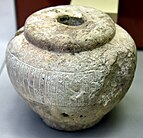Our website is made possible by displaying online advertisements to our visitors.
Please consider supporting us by disabling your ad blocker.
Gutian rule in Mesopotamia
Gutian Dynasty of Sumer | |||||||||
|---|---|---|---|---|---|---|---|---|---|
| c. 2141 BC–c. 2050 BC | |||||||||
| Capital | Adab | ||||||||
| Common languages | Gutian language and Sumerian language | ||||||||
| Government | Monarchy | ||||||||
• fl. c. 2141—2138 BC | Erridu-pizir (first) | ||||||||
• fl. c. 2055—2050 BC | Tirigan (last) | ||||||||
| Historical era | Bronze Age | ||||||||
• Established | c. 2141 BC | ||||||||
• Disestablished | c. 2050 BC | ||||||||
| |||||||||
| Today part of | Iraq | ||||||||
The Gutian dynasty (Sumerian: 𒄖𒋾𒌝𒆠, gu-ti-umKI) was a line of kings, originating among the Gutian people. Originally thought to be a horde that swept in and brought down Akkadian and Sumerian rule in Mesopotamia, the Gutians are now known to have been in the area for at least a century by then. By the end of the Akkadian period, the Sumerian city of Adab was occupied by the Gutians, who made it their capital.[1][2] The Gutian Dynasty came to power in Mesopotamia near the end of the 3rd millennium BC, after the decline and fall of the Akkadian Empire. How long Gutian kings held rulership over Mesopotamia is uncertain, with estimates ranging from a few years up to a century. The end of the Gutian dynasty is marked by the accession of Uruk ruler Utu-hengal (c. 2055–2048 BC), marking the short-lived "Fifth dynasty of Uruk", followed by Ur ruler Ur-Nammu (c. 2047–2030 BC), founder of the Third Dynasty of Ur.
There are very few hard facts available regarding the rulers of the Gutian Dynasty, still fewer about the Gutian people; even their homeland is not known. We have a few royal inscriptions from one ruler, Erridu-pizir, an inscribed macehead from another, La-erabum, a handful of passing mentions from contemporary Mesopotamian rulers, and one long inscription by Uruk ruler Utu-hengal. And there are the many versions of the Sumerian King List, most recensions of which were written long after the time of the Gutian Dynasty and give different, sometimes conflicting versions of history. The earliest version of the Sumerian King List, written in the Ur III period, not long afterward in time, does not mention the Gutians and lists a Gutian ruler, Tirigan, as a king of Adab.[3] Yet the SKL remains our only source for most Gutian kings.
Still, clearly the Gutian rulers had a huge impact on late–3rd-millennium Mesopotamia, reflected in the vast array of literary compositions featuring them, continuing for almost two millennia.
- ^ M. Molina, "The palace of Adab during the Sargonic period", D. Wicke (ed.), Der Palast im antiken und islamischen Orient, Colloquien der Deutschen Orient-Gesellschaft 9, Wiesbaden: Harrassowitz 2019, pp. 151-20
- ^ Susanne Paulus, "Fraud, Forgery, and Fiction: Is There Still Hope for Agum-Kakrime?", Journal of Cuneiform Studies, vol. 70, pp. 115–66, 2018
- ^ Steinkeller, Piotr., "An Ur III Manuscript of the Sumerian King List.", In Literatur, Politic und Recht in Mesopotamien: Festschrift für Claus Wilcke, ed. Walther Sallaberger et al. 267–92, 2003 Orientalia Biblica et Christiana 14. Wiesbaden: Harrassowitz
- ^ The Sumerian Kings List (PDF). p. 119, note 305.
Previous Page Next Page




